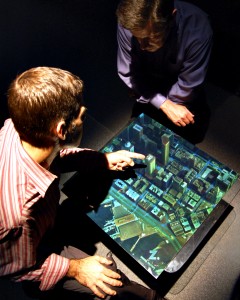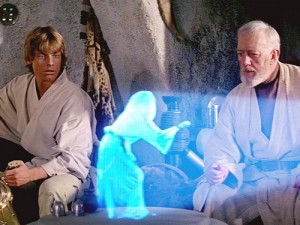Holograms are not a thing of sci-fi any longer. Like Princess Leah in the first Star Wars movie, you could be sending your next client a hologram of building design. The technology, originally designed for military purposes, has reached a point where printing a hologram of a building competes with the traditional hand built approach. This is especially true if you already have a 3D model model created in Revit or another BIM software package.
A hologram is a great option that provides a lot more information than a computer rendering and has the physicality of a hard model. You can look at it from the side, the top, the bottom, twist it around, all without worrying that you, your client or the delivery man will damage any part of the hologram model. It’s amazing, and hard to imagine until you’ve seen it with your own eyes.

A hologram created by Zebra for urban planning purposes. See the video below to fully perceive the the 3D nature of this image.
Holograms are “printed” come on a film, much like mylar. The incredibly accurate printers used to make holograms cut the film at ultra-precise angles so that when a light is shined directly down onto the holographic film the reflected rays create an image in 3D space. The holographic model created can appear to project out pf the film surface by about 12″on average. The first 8″ is very focused, and as the image gets further from the film surface it becomes less focused.
This exciting technology provides architects with many advantages:
- The hologram can be easily duplicated or reproduced with revisions.
- Holograms are significantly more durable and easier to carry than a physical model.
- Holograms are also very easy to store, which if you ever had to trash a model because you were out of space in the studio, is much easier emotionally.
- The amount of detail that is achieved is typically better than physical model. The accuracy is greater than a rapid prototyping model when it comes to color, texture and the level of detail.
Lanmar has worked with Zebra Imaging in the past to produce holograms for architectural clients. Below is a video from Autodest University that gives you a much better idea of what these holograms are like than any stationary image:

